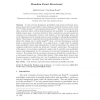Free Online Productivity Tools
i2Speak
i2Symbol
i2OCR
iTex2Img
iWeb2Print
iWeb2Shot
i2Type
iPdf2Split
iPdf2Merge
i2Bopomofo
i2Arabic
i2Style
i2Image
i2PDF
iLatex2Rtf
Sci2ools
IJSI
2008
2008
Random Event Structures
Abstract In a line of recent development, probabilistic constructions of universal, homogeneous objects have been provided in various categories of ordered structures, such as causal sets[12] , bifinite domains[13] , and countable partial orders[10] . These constructions have been shown to produce objects with the desired properties with probability 1 in an appropriately defined measure space. A common strategy for these constructions is successive point-wise extension of an existing finite structure, with decisions on the relationships between the newly added point and the existing structure made according to well-specified probabilistic choices. This strategy is a departure from (and understandably so due to the increased complexity) the original one for random graphs[16] where a universal homogeneous countable graph is constructed with probability 1 in a single step (i.e., a single round of countably many probabilistic choices made independently). It would be interesting to see whic...
| Added | 12 Dec 2010 |
| Updated | 12 Dec 2010 |
| Type | Journal |
| Year | 2008 |
| Where | IJSI |
| Authors | Manfred Droste, Guo-Qiang Zhang |
Comments (0)

